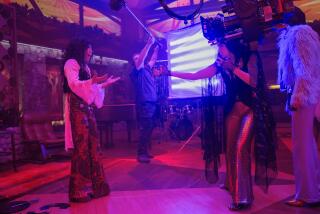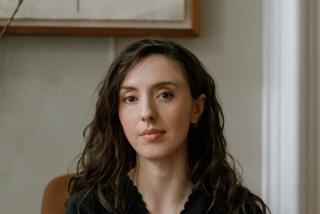The Trials of Being a Witch : Lifestyles: Salem is about to commemorate the 300th anniversary of one of its darker chapters, but has not asked a witch to join in. Trouble is brewing.
- Share via
SALEM, Mass. — Being a witch these days is not without its trials. Just ask Laurie Cabot.
“Are we being trivialized? Absolutely,” said Cabot, named by former Gov. Michael Dukakis as the state’s official witch in 1975.
Cabot might have been bemoaning Salem’s town symbol (a witch on a broomstick), which is “degrading to witches and to women.” She might have been griping about Salem’s privately run Witch Museum, which features a film purporting to re-create the hysteria that overtook this community in 1692 when 23 men and women were executed for witchcraft. She might even have been complaining about the high school football squad that calls itself the Salem Witches.
But what Cabot and some other witches here are upset about this Halloween season is the fact that no practicing witch has been asked to participate in the Salem Witch Trials Tercentenary, the official commemoration of the most infamous event ever to occur in this area.
The yearlong observation of what is known locally as “witch hysteria” begins next month with the unveiling of a permanent Witchcraft Memorial. Among the highlights of the 300th anniversary celebration are an essay contest, a “seaport spectacular” with a parade of ships, a symposium on religious tolerance and a re-enactment of the original witch trials starring Harvard Law School Prof. Alan Dershowitz, who will argue that the trials violated the civil rights of the accused.
“I think they want to ignore the fact that we (witches) are alive and well,” Cabot said, as she brushed a long streak of hair--dyed coal black, smoky gray and glittering silver--out of her face. “I think it’s OK for them to commemorate, but they’re leaving us out.”
Omitting real witches from the Tercentenary Committee is a “strange and quite bizarre” thing to do, said Gypsy Ravish, also a practicing witch here.
Added Shawn Poirier, a practicing witch who also does psychic readings here: “I think it is very unfair that they are exploiting the death of people who were harmed and killed in Salem 300 years ago. And I think it’s very sad that they are not opening up to the truth about what witchcraft really is.”
Linda McConchie, the executive director of the Salem Witch Trials Tercentenary, said she can understand the witches’ frustration.
“Laurie Cabot and the other practicing witches here (Cabot estimates that there are 2,400 in Salem) are very serious about their religion,” McConchie said. “I have every respect for their religion and their right to practice it. No one, not I nor anyone on this committee, thinks that witchcraft is a joke.”
But “as a municipal committee, it is not appropriate for us to have an analysis of a religion” included in what is already a very full schedule, McConchie said. “We have a criterion that says we will be neutral about religious practices,” she explained.
In his high-ceilinged office in a building designed by Charles Bulfinch, Salem Mayor Neil J. Harrington was more blunt.
“The Tercentenary has nothing to do with modern witchcraft,” Harrington said. “It is focused on innocent victims who were victims of mass hysteria.”
By seeking inclusion in the Tercentenary, Harrington said, Cabot and other contemporary witches “are trying to inject themselves into a controversy that has nothing to do with them.” The 23 people who were hanged and pressed to death here in 1692 “were not witches,” Harrington said. “They were Christians.”
But Ravish, who runs a witchcraft and New Age supply house called White Light Pentacles with her husband and fellow witch, Richard, dismissed the separation-of-church-and-commemoration argument. “They don’t want to endorse religion?” she asked. “Well by even having this commemoration, they’re endorsing Puritanism--and they’re not showing a witch point of view.”
And Cabot, in her 18th-Century home not far from the Salem waterfront, said, “There is no proof, no proof whatsoever, that those people either were witches or were not witches.”
What is known, and what is undisputed, is that on Jan. 20, 1692, in the village of Salem, 9-year-old Elizabeth Parris and 11-year-old Abigail Williams began to shout out blasphemies, experience compulsive seizures, fall into trance-like states and suffer from spells.
Soon after, several other girls began displaying the same strange behavior. When no physical cause was discovered, doctors concluded that the girls were under the influence of Satan.
Right there, Laurie Cabot takes exception with the very idea that Satanic possession had anything to do with what came to be known as the Salem Witch Trials. She points out that witchcraft is a god- and goddess-based religion that worships nature. Satan, she said, has never had a role in witchcraft, a religion of Celtic origin.
Cabot said it was Christians throughout the ages who associated their own belief with witchcraft. She also maintains that historians have sometimes misunderstood the practice of witchcraft and that her religion has basically suffered from bad press.
“We don’t have a devil,” Cabot said. “The accusations were that we did night flying, that we consorted with the devil and that we harmed people. Witches don’t do those things.”
But Cabot was not around to defend the 141 men and women who were accused of being witches in 1692. She was not there to take exception when Tituba, the Carib Indian slave of Elizabeth Parris’ family, confessed to seeing the devil, who appeared to her “sometimes like a hog and sometimes like a great dog.” Tituba also testified that there was a great conspiracy of witches at work in Salem.
As townspeople began to come forward and report that they, too, had seen strange apparitions of some of the community members, 141 residents were accused. In the end, 58 people were indicted and 29 convicted.
Before Gov. William Phipps saw fit to order that reliance on “spectral and intangible evidence” could no longer be allowed in trials and pardoned the remaining prisoners, 23 had been executed.
Witches today think of what happened in Salem 300 years ago as “our Holocaust,” Cabot said. And McConchie, of the Tercentenary Committee, lamented the witch trials as “a tragedy, a shameful period” in colonial America.
But although it is ignominious, “the fact that the trials happened here” is still “an attraction” for the thousands of visitors who flock to Salem each year, said historian Alison D’Amario, education director at the Witch Museum.
And those tourists do not care whether there is a connection between 17th-Century witch trials and 20th-Century witches. A recent study conducted at Salem State College, Salem Mayor Harrington said, showed that “the No. 1 reason that people come to Salem is to see the witches.”
Laurie Cabot, for one, is happy to cater to the tourists. She has a mail-order potion company, the Magic Door. She has written a book about her life, “Power of the Witch.” She has given her name to a shop run by her daughter that sells talismans and crystal balls. Cabot calls the shop “a witches’ supermarket,” offering “everything you need to be a witch.”
With her flowing hair, heavy makeup and long robes, emblazoned with pentagrams and adorned with jewelry, the 60-year-old Cabot is a familiar figure on the streets of Salem. Her “ritual attire,” she said, is part of the vows she has taken as a high priestess who conducts classes in witchery and performs marriages and other ceremonies.
Cabot said the very fact that so many people regard her as a kind of local curiosity is why at least one witch should have been included in the commemoration of the Salem Witch Trials. “People here like us. We’re very visible,” Cabot said. “They know that when their relatives come from Georgia or Los Angeles, they can point to me and say ‘That’s our witch.
“If you were going to have a ceremony about what happened at Dachau, you wouldn’t only present it from the Nazi point of view,” Cabot fumed.
In fact, no one on the Tercentenary Committee would quarrel with Cabot’s position that one of the largest lessons of what happened here in 1692 is tolerance for religious differences. Including Cabot or any other known witch in the commemoration, however, is another matter.
Cabot said the modern-day witches are asking for respect, not high-profile participation.
“We don’t want to parade down the street,” she said. “We don’t want to show up in green-face, like Dorothy Whats-her-face in ‘The Wizard of Oz.’
“We don’t want to re-enact anything,” Cabot said. “We don’t have to. We’re already here.”
More to Read
Sign up for Essential California
The most important California stories and recommendations in your inbox every morning.
You may occasionally receive promotional content from the Los Angeles Times.













